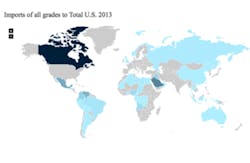The U.S. Energy Information Administration has released a new U.S. Crude Oil Import Tracking Tool designed to allow policymakers, analysts, and the public to more easily track trends in crude oil imports. Users can sort and display crude oil imports by month or year, by crude type (i.e., light, medium, heavy), country source, port of entry, processing company, processing refinery, and more. The tool features graphing and mapping capabilities and a built-in help function.
Recent and forecast increases in domestic crude production have sparked discussion about how rising crude oil volumes will be absorbed. To date, a primary mechanism for absorbing increased production has been the displacement of imported crude oil, which has fallen from 8.9 million barrels per day (bbl/d) in 2011 to 7.5 million bbl/d in August 2014.
READ ALSO: Oil Shale Crude Production to Boost US Refining Capacity Expansion to $4B by 2020
The EIA says this tool sheds light on the adjustments to imports being made in response to growing production of crude oil within the United States. It is one part of EIA's ongoing effort to assess the effects of a possible relaxation of current limitations on U.S. crude oil exports, which is another avenue to accommodate domestic production growth. EIA is undertaking further work on this larger question, and expects to issue more analysis reports over the coming months.
The tool was launched on EIA's beta site to solicit customer feedback, and incorporate that feedback into the final release.
The tool allows users to access information from EIA's monthly Company Level Import database for different time periods, regions, companies, and crude oil qualities. Using the tool yielded the following insights regarding recent trends in U.S. crude oil imports:
- Volume and quality of U.S. crude oil imports: U.S. crude oil imports have declined since 2010, with nearly all of the decline occurring in light sweet grades. In particular, U.S. light crude imports fell 71 percent between 2010 and the period January through August 2014.
- Source of U.S. crude oil imports: Imports of light crude from Africa, particularly from Nigeria and Algeria, have declined by 93 percent.
- Light crude oil imports by region:The largest decline in crude oil imports occurred on the Gulf Coast (PADD 3), down 94 percent. Light crude oil imports by East Coast (PADD 1) refiners were down 69 percent, reflecting both their increased use of domestic crudes and modestly lower refinery runs.
- Refinery-level trends in light crude imports: Imports by the 10 largest refineries using imported light crude in 2013 accounted for 55 percent of total U.S. light crude imports, with the remaining 45 percent scattered among more than 100 other refineries. The largest source for light crude imports among this group of 10 refineries was Canada, followed by Nigeria and Mexico. Of these 10 refineries, three are located on the East Coast, two in the Midwest, three on the Gulf Coast, and two on the West Coast.
- Refinery-level trends in imports other than light sweet crude:There is evidence that some refineries have recently reduced imports of medium and heavy grades of crude oil in order to accommodate increasing light domestic production. Other refiners, which have made changes in processing equipment to accommodate heavier crudes, have increased their imports of such crudes.


